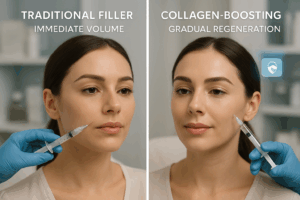Scarring is an inevitable part of the healing process following plastic surgery. However, understanding the nature of scars and how to manage them can significantly improve their appearance. This blog will explore the phases of scar formation, types of scars, and strategies to optimize scar healing before, during, and after plastic surgery.
What Are Scars?
Scars form as a natural response to skin injury, including surgical incisions. The process involves several phases:
- Inflammatory Phase: This initial phase involves redness and swelling as the body’s immune response kicks in to prevent infection.
- Proliferation Phase: New tissue forms to close the wound, often resulting in a raised scar.
- Maturation or Remodeling Phase: The scar gradually flattens and fades over time, sometimes taking up to a year or more.
Scars can vary in appearance based on genetic factors and the body’s healing response. Two common types of problematic scars are:
- Hypertrophic Scars: Raised scars that remain within the boundaries of the original wound.
- Keloid Scars: Overgrown scars that extend beyond the original wound site.
Optimizing Scars During Plastic Surgery
During surgery, several techniques can help minimize scarring:
- Tension-Free Closure: Reducing tension on the wound edges helps prevent widening of the scar.
- Ensuring Good Blood Flow: Adequate blood supply is crucial for healing and minimizing scar formation.
- Suture Selection: Using permanent sutures and avoiding excessive absorbable sutures can improve scar outcomes.
Post-Surgery Scar Management
Proper care immediately after surgery is vital for optimal scar healing:
- Follow Post-Operative Instructions: Adhering to your surgeon’s guidelines can prevent complications.
- Nutritional Support: Consuming adequate protein, vitamins, and minerals supports healing.
- Health Optimization: Managing conditions like diabetes and avoiding smoking can enhance recovery.
- Silicone Gel Bandages: These can help flatten and soften scars.
- Sun Protection: Protecting scars from UV exposure prevents darkening and thickening.
- Advanced Treatments: Options like steroid injections, pressure dressings,Botox injections around the scar, microneedling, and laser treatments may be recommended for stubborn scars.
What to Avoid After Surgery
Certain products and practices can hinder scar healing and should be avoided:
- Essential Oils and Bleaching Agents: These can irritate the skin and worsen scarring.
- Homemade Body Oils and Heavy Fragrances: These may cause allergic reactions or irritation.
Conclusion
While scarring is a natural part of the healing process, understanding and implementing effective scar management techniques can significantly reduce their visibility. By following pre- and post-operative care instructions, choosing the right surgical techniques, and avoiding harmful products, patients can achieve the best possible outcomes for their scars after plastic surgery.
Consult now!




Recent Comments